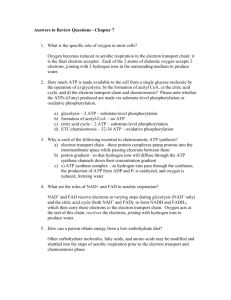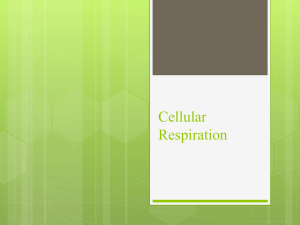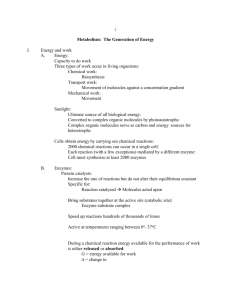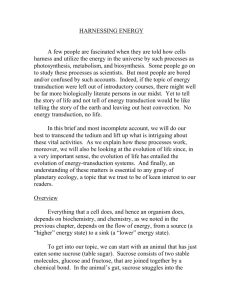Glenco-chapter-8
advertisement
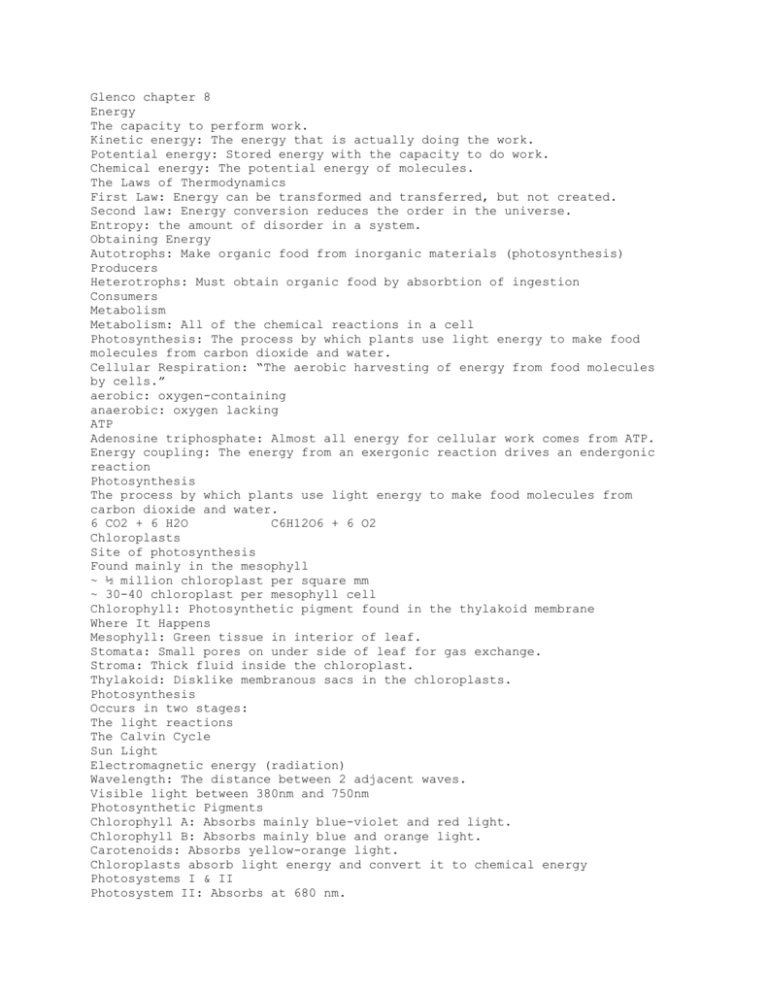
Glenco chapter 8 Energy The capacity to perform work. Kinetic energy: The energy that is actually doing the work. Potential energy: Stored energy with the capacity to do work. Chemical energy: The potential energy of molecules. The Laws of Thermodynamics First Law: Energy can be transformed and transferred, but not created. Second law: Energy conversion reduces the order in the universe. Entropy: the amount of disorder in a system. Obtaining Energy Autotrophs: Make organic food from inorganic materials (photosynthesis) Producers Heterotrophs: Must obtain organic food by absorbtion of ingestion Consumers Metabolism Metabolism: All of the chemical reactions in a cell Photosynthesis: The process by which plants use light energy to make food molecules from carbon dioxide and water. Cellular Respiration: “The aerobic harvesting of energy from food molecules by cells.” aerobic: oxygen-containing anaerobic: oxygen lacking ATP Adenosine triphosphate: Almost all energy for cellular work comes from ATP. Energy coupling: The energy from an exergonic reaction drives an endergonic reaction Photosynthesis The process by which plants use light energy to make food molecules from carbon dioxide and water. 6 CO2 + 6 H2O C6H12O6 + 6 O2 Chloroplasts Site of photosynthesis Found mainly in the mesophyll ~ ½ million chloroplast per square mm ~ 30-40 chloroplast per mesophyll cell Chlorophyll: Photosynthetic pigment found in the thylakoid membrane Where It Happens Mesophyll: Green tissue in interior of leaf. Stomata: Small pores on under side of leaf for gas exchange. Stroma: Thick fluid inside the chloroplast. Thylakoid: Disklike membranous sacs in the chloroplasts. Photosynthesis Occurs in two stages: The light reactions The Calvin Cycle Sun Light Electromagnetic energy (radiation) Wavelength: The distance between 2 adjacent waves. Visible light between 380nm and 750nm Photosynthetic Pigments Chlorophyll A: Absorbs mainly blue-violet and red light. Chlorophyll B: Absorbs mainly blue and orange light. Carotenoids: Absorbs yellow-orange light. Chloroplasts absorb light energy and convert it to chemical energy Photosystems I & II Photosystem II: Absorbs at 680 nm. Has a special pair of chlorophyll molecules called P680. Photosystem I: Absorbs at 700 nm Has a special pair of chlorophyll molecules called P700. The Light Reaction Light energy hits P680 and excites 2 electrons. The electrons are passed to primary electron acceptor. Electron passed down electron transport chain providing energy for ATP synthesis. Electrons passed to P700. Light Reaction Part 2 Light at 700 nm excites electrons at P700. Electrons passed to primary electron acceptor and down the electron transport chain. The energy released is used to reduce NAD+ to NADPH Calvin Cycle Assembles sugar molecules from CO2 and energy-containing products of the light reactions. (Carbon fixation) ATP NADPH Alternative Pathways C4 plants: Fix carbon into a 4 carbon molecule and store it for later use (corn) CAM plants: Crassulacean Acid Metabolism, fixes carbon at night (cacti, pineapple) Both pathways conserve water Glucose A simple sugar (C6H12O6) Atoms held together by covalent bonds Cellular Respiration The breaking down of glucose to get ATP. C6H12O6 + 6 O2 6 CO2 + 6 H2O + ATP Glucose Oxygen Carbon Water Energy dioxide REDOX Reactions If the substance losses H than it is oxidized. If the substance gains H than it has been reduced. C6H12O6 + 6 O2 6 CO2 + 6 H2O + ATP Metabolic Pathway Stage 1: Glycolysis: (exergonic) The breaking down of glucose Energy-requiring steps (investment) ATP energy activates glucose and its six-carbon derivatives Energy-releasing steps (payback) The products of the first part are split into three-carbon pyruvate molecules ATP and NADH form Glycolysis: Net Energy Yield Energy requiring steps: 2 ATP invested Energy releasing steps: 2 NADH formed 4 ATP formed Net yield is 2 ATP and 2 NADH Second Stage Reactions Preparatory reactions Pyruvate is oxidized into two-carbon acetyl units and carbon dioxide NAD+ is reduced Krebs cycle The acetyl units are oxidized to carbon dioxide NAD+ and FAD are reduced Krebs Cycle Completes the oxidation of organic fuel For every glucose molecule: 2 ATP, 6 NADH, 2 FADH2 Stage 3: E.T.C. & Chemiosmosis Occurs in the mitochondria membrane Coenzymes deliver electrons to electron transfer chains Electron transfer sets up H+ ion gradients Flow of H+ down gradients powers ATP formation Importance of Oxygen Electron transport phosphorylation requires the presence of oxygen Oxygen withdraws spent electrons from the electron transfer chain, then combines with H+ to form water Oxygen is the final electron acceptor Summary of Energy Harvest (per molecule of glucose) Glycolysis 2 ATP formed by substrate-level phosphorylation Krebs cycle and preparatory reactions 2 ATP formed by substrate-level phosphorylation Electron transport phosphorylation 32 ATP formed Total of 38 ATP molecules Fermentation Alcoholic fermentation: Replenishes NAD+ supply in an anaerobic environment with ethanol as bi-product. Lactic acid fermentation: Replenishes NAD+ supply in an anaerobic environment with lactic acid as a bi-product Fermentation Pathways Begin with glycolysis Do not break glucose down completely to carbon dioxide and water Yield only the 2 ATP from glycolysis Steps that follow glycolysis serve only to regenerate NAD+

